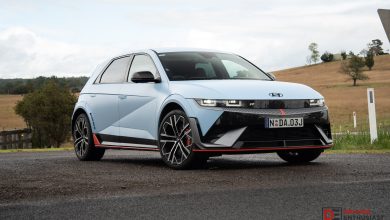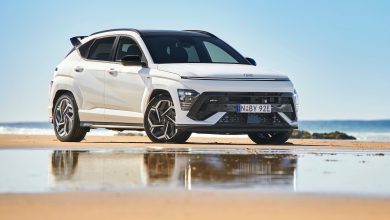After some delays, the 2025 Hyundai i30 N Line has arrived in Australia, offering a fresh new take on the popular warm hatch by featuring mild-hybrid power.
It remains turbocharged, so it still has a sporty flavour, but power and torque are down compared with the outgoing 1.6 turbo. Will the expected fuel consumption benefits outweigh the drop in performance? Let’s take a look.

2025 Hyundai i30 N Line Premium 48V: Specifications
Engine: 1.5-litre turbo four-cylinder mild-hybrid
Electrical: 48V/0.44kWh battery, 11.8kW e-motor
Output: 117kW@5500rpm / 253Nm@1500-3500rpm
Gearbox: Seven-speed dual-clutch auto
Drive type: Front-wheel drive
Wheels: F & R: 18×7.5, 225/40
ANCAP: Not tested
Tare weight: 1439kg
Power-to-weight: 8.20:1 (kg:kW)
Official consumption: 5.6L/100km
Our consumption: 6.7L/100kmFuel tank/Fuel type: 50L/91 RON
Power efficiency: 21.12kW:L/100km
0-60km/h: 3.95 seconds*
0-100km/h: 8.18 seconds*
60-110km/h: 5.54 seconds*
1/4 mile: 16.06 seconds at 148.8km/h*
Max acceleration: 0.632g*
100-0km/h braking: 36.83m in 2.83 seconds*
Max deceleration: -1.270g*
Decibel at idle: 40*
Peak decibel at 60-100km/h: 78*
Starting price: $41,000
*Figures as tested by Driving Enthusiast on the day. Manufacturers’ claims may be different
2025 Hyundai i30 N Line Premium 48V: How much does it cost?
Just two variants make up the 2025 i30 hatch range, excluding the high performance N model. There’s the N Line and the N Line Premium. Prices start from $36,000 and $41,000, respectively (excluding on-roads). No manual option is available, only a seven-speed dual-clutch auto.
Comparing with the outgoing 2023 model, in top auto N Line Premium form, it started from $37,020 when new. That’s about $4000 more for the mild-hybrid package. However, this does include some other tech and equipment enhancements over the previous model.

2025 Hyundai i30 N Line Premium 48V: Interior & packaging
Hyundai has upped its game here adding a new 10.25-inch digital instrument cluster for the driver, with somewhat customisable themes via the three-setting driving modes (Eco, Normal, Sport). Another 10.25-inch screen is used for the multimedia system but only on the Premium. The regular variant gets an 8.0-inch setup.
As before, the screens offer good graphics and presentation, with easy-flow menus and a nice grid-style layout for the main apps page. It connects via Android Auto and Apple CarPlay as well, and the Premium adds in-built sat-nav, voice command, heated front seats and steering wheel, sunroof, and Hyundai’s latest Bluelink car connectivity service.

The N Line trim comes with sport seats in a combination of synthetic suede and leather, providing both comfort and support. There’s plenty of red stitching and sporty accents to remind you that this isn’t your average hatchback, and the cabin remains spacious for its class, with enough room for four passengers to sit comfortably, or five if they aren’t fat.
Boot space is rated at 395L, or 1301L with the rear seats folded. Due to the 48V, 0.44kWh, LiPD Li-Ion Polymer battery positioned under the boot floor, there is no spare wheel only a repair kit. The capacity is the same as the old 1.6T though, so it looks like the repair kit has been implemented so storage space isn’t compromised.

Even though it is getting a bit old now, this shape and body structure, it remains a good-looking package in my opinion. The N Line treatment, extending to bespoke side skirts, rear diffuser, twin-tip exhaust, and front and rear spoilers, looks athletic and muscular. And the upright cabin orientation with tall windows (compared with some more modern designs) means visibility is excellent.

2025 Hyundai i30 N Line Premium 48V: Powertrain & handling
Under the bonnet is a new (for Australia) 1.5-litre turbocharged petrol four-cylinder engine, paired with a 48-volt mild-hybrid system. An electric motor/generator is attached to the engine like an alternator, and receives power from the 0.44kWh battery.
Output is listed at 117kW at 5500rpm, and 253Nm between 1500-3500rpm. The electric motor can provide 11.8kW alone. It’s a fairly meaty mid-range output for a 1.5-litre engine, with everything over by just 5500pm. But, it’s not as broad-reaching or as strong as the previous 1.6L turbo.
The outgoing 1.6T produced 150kW at 6000rpm, and 265Nm between 1500-4500rpm. In other words, the new 1.5L is inferior in terms of grunt and capability. Perhaps most importantly, what does our ‘power:efficiency’ ratio look like?

This new powertrain offers an official average consumption of 5.6L/100km. Take 117kW and divide by 5.6 and you’re left with a ratio of 20.89kW:L/100km. In the old 1.6 turbo, it was rated at 7.1L/100km in auto Premium form, which means a ratio of 21.12kW:L/100km. This new setup is not as power-efficient as the 1.6T.
That’s not to say it isn’t as economical. It offers lower consumption and the potential for lower consumption in the real world. Our week-long test returned an average of 6.7L/100km, including performance testing. Emissions are also much lower, at 126g/km compared with 167g/km in the 1.6T.

Starting it up first thing in the morning, it is surprisingly noisey and a bit rough, almost like a three-cylinder. However, it’s worth noting we were the first publication with this test car, which had just 850km on the clock when we picked it up. So with some more run-in time the engine could free up a bit and run slightly smoother.
In saying that, it is characterful and animated with its roaring mid-range sound, and there is a neat exhaust parp during upshifts. Does it feel as ‘exciting’ as the old 1.6 turbo? Most of the time, yes. It doesn’t feel all that different, and you can feel a faint surge from the electric motor at times.
Across the usual sprints, we clocked 0-100km/h in a best of 8.18 seconds, with the quarter mile crossed in 16.06 seconds at 145.8km/h. The last time we tested an i30 N Line hatch with the dual-clutch transmission (in 2019), it did 0-100km/h in 7.12 seconds and the quarter in 15.41 seconds at 151.9km/h. You can check out all of our previous times in our Vbox data table here.

On the road, the i30 N Line handles corners with confidence. The suspension is firm but not overly harsh, striking a good balance between sportiness and comfort. The 18-inch alloy wheels and sport-tuned suspension certainly add to the dynamic feel, wearing 225/40 Michelin Pilot Sport 4 tyres.
It is one of the best-handling hatchbacks on the market in my opinion. The turn-in is sharp but the body control is wonderful, railing around corners like a proper hot hatch. Obviously the serious i30 N hatch is based on this, and you can certainly feel the lineage here – even without the adaptive suspension and extra chassis bracing featured on the N. This is lots of fun and yet highly accomplished and it’s good to see it retains a multi-link rear end.

2025 Hyundai i30 N Line Premium 48V: Key attractions/reasons to buy
- Sporty design: The N Line trim, with its restyled front grille, side skirts, and 18-inch alloy wheels, gives the i30 an athletic stance, despite getting a bit old.
- Mild-hybrid tech: Offers improved fuel efficiency and lower emissions on paper and thus the potential to offer reduced figures in the real world as well.
- Tech-savvy interior: Standard 10.25-inch digital instrument cluster and available Bluelink connected car services.
- Practicality: Despite its sporty focus, the i30 N Line is still a practical small car with excellent boot space and plenty of room for passengers, with good outward visibility compared with some more modern packages.
2025 Hyundai i30 N Line Premium 48V: Key considerations before you buy
- No full hybrid: The mild-hybrid system is more efficient than a standard petrol engine, but it’s not as fuel-efficient as a full hybrid.
- Price: Starting from $36,000, the i30 N Line is competitively priced today, but some may find better value in non-hybrid alternatives. It has also climbed around $4000 over the predecessor.
- Limited performance: While the 1.5-litre engine offers decent power and torque for its size, it delivers a lot less power compared with the previous 1.6 turbo, and it’s about a second slower across 0-100km/h.
2025 Hyundai i30 N Line Premium 48V: Video
How does it rate against its rivals?
- Price
- Interior tech
- Powertrain performance
- Ride & handling
- X-factor (does it stand out in its class?)
Final word
With mild-hybrid technology it is a bit slower and down on power compared with the old 1.6 turbo, and a tad more expensive. But all of the charm and character is still here; neat yet muscular N Line aero kit, brilliant handling, decent engine sound, and superb practicality.

























